Gradall Hydraulic Excavator; a world first!
Posted by Chris Graham on 7th February 2023
Keith Haddock reviews the history of the Gradall Hydraulic Excavator, which is claimed to be the world’s first machine of its type.
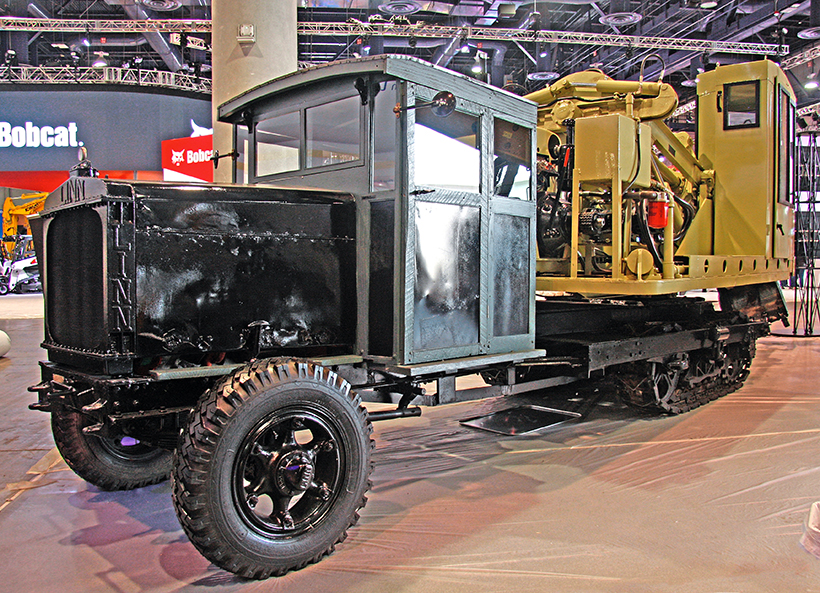
Gradall Hydraulic Excavator: Manufactured in 1945, this is one of the first five Gradall excavators built. Seen here mounted on a Linn half-track carrier, it was on display at the 2020 Conexpo equipment exhibition in Las Vegas.
You can recognise a Gradall by its distinctive telescoping boom. Built since the early 1940s, and produced in the same factory at New Philadelphia, Ohio, USA since 1950, the Gradall Company is alive and well today, building machines to serve a niche market. Its innovative boom, which rotates as well as telescopes, adds additional flexibility to the use of hydraulic excavators, allowing the Gradall to perform work beyond the capability of other machines.
Before the recent introduction of bucket rotary and tilt excavators with their many digging movements, the standard hydraulic excavator had only four: boom hoist, bucket arm, wrist action and swing. The Gradall boasts an additional bucket tilt feature resulting in five movements to be coordinated simultaneously by the operator. The regular bucket arm not only telescopes in and out like a hydraulic crane, but the carriage supporting the boom rotates longitudinally allowing the bucket to tilt left or right. Boom hoist, bucket wrist action and machine swing complete the five movements.
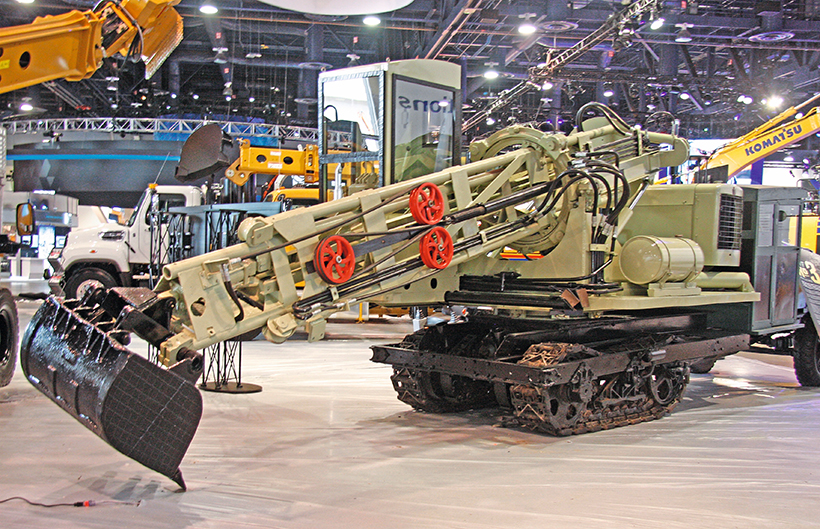
Showing the boom arrangement on an original Gradall.
A skilled operator can master the five movements to utilise the machine’s full potential in precise finishing operations, eliminating any hand labour. The telescopic boom can reach under and around obstacles, or let the bucket dig vertically downward. The longitudinal boom rotation can vary the bucket at any angle from 0 to 90 degrees either side, so that slopes of varying angles can be cut – a huge advantage in final trimming or landscaping. In trenching, side slopes can be cut for maximum safety.

Model 2460, the upgraded model introduced in 1950 immediately after Warner & Swasey purchased manufacturing rights to Gradall.
A further advantage is that the Gradall boom applies a constant force to the bucket throughout the digging cycle, unlike conventional pivoting booms that deliver varying forces. An additional safety feature is that the hydraulic hoses are well protected inside the boom. In the driver’s cab of the modern Gradall, all five digging motions as well as travel motions are controlled through joystick levers and foot pedals. The joystick pattern can be changed to suit driver preference.
An array of attachments has further expanded the Gradall’s applications, and changing attachments is easily performed with the quick-change bucket connection. Steel mills have found the Gradall’s telescoping capability, when equipped with a scarifier tooth or hydraulic breaker, ideal for reaching in and cleaning out hard furnace slag. For work in hazardous conditions, Gradalls can be controlled remotely by radio transmitter.
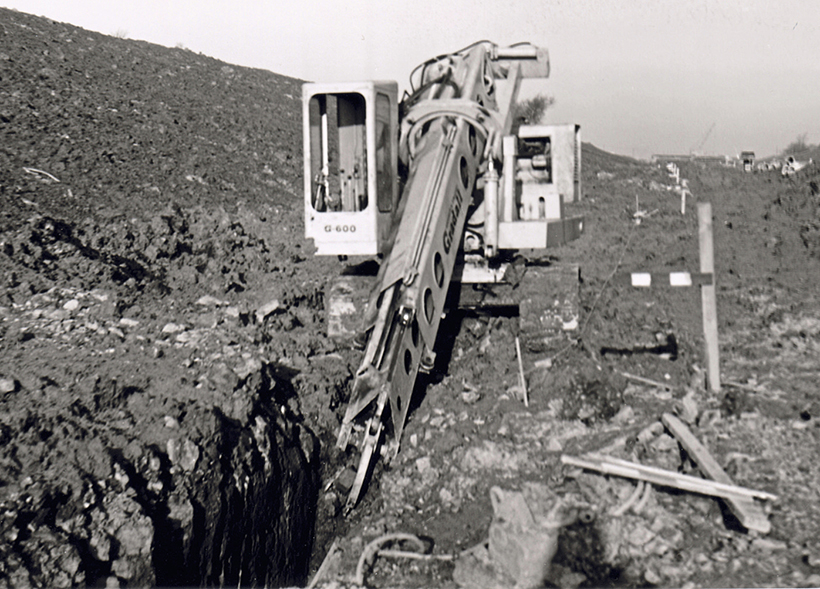
A crawler-mounted G-600 helps cut a drainage ditch with a scarifier tooth on an M1 motorway construction site near Stavely, Derbyshire, in 1967.
Gradall development
As with many other equipment innovations, the Gradall resulted from a contractor’s need. Back in the early 1940s, World War II had created a severe labour shortage in America. Ray and Koop Ferwerda, brothers originally from the Netherlands, became partners in a leading Cleveland firm of civil engineering contractors. They needed to fine-grade steep slopes on road construction projects, a job normally done by hand, so they invented a fully-hydraulic truck-mounted telescopic boom with a fixed blade at the end to smooth the dirt at any angle. Improving on the original design, they added tilt and wrist motions and a bucket, allowing the machine to excavate as well as trim in three dimensions.
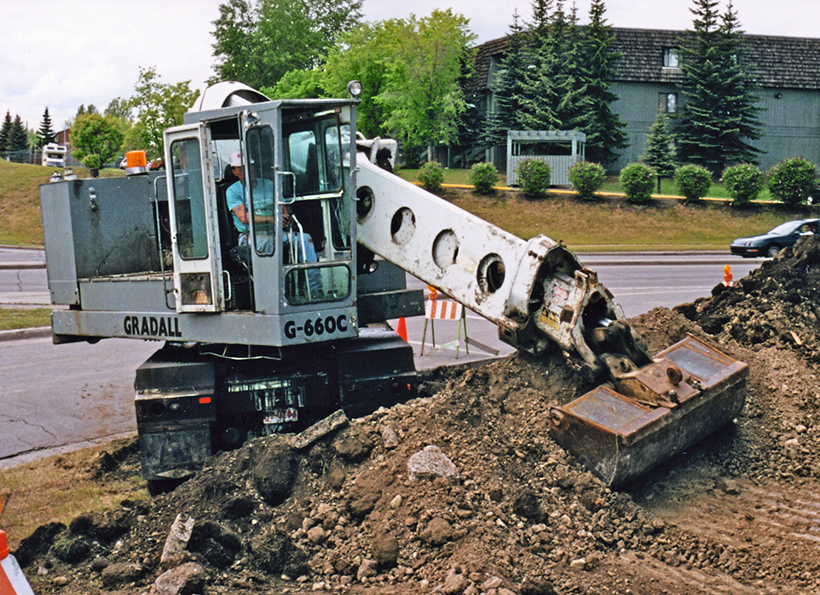
A truck-mounted G-660C shapes a city road embankment.
The first of these machines was installed on a government-surplus truck in 1941 and attracted much attention. The concept was so successful that four more were built on second-hand Linn half-track carriers up to 1945. One of these early Gradalls built in 1942 made public appearances in restored condition at the 2020 and 2022 Conexpo equipment exhibitions at Las Vegas. The upper structure of this early machine was powered by an International Harvester six-cylinder petrol engine, while the Linn half-track carrier employed a Waukesha 210-cubic-inch petrol engine. A chain mechanism controlled the upper rotation which was not continuous, just like the early Hy-Mac 480 excavators. Digging movements were controlled by three levers and two foot pedals.
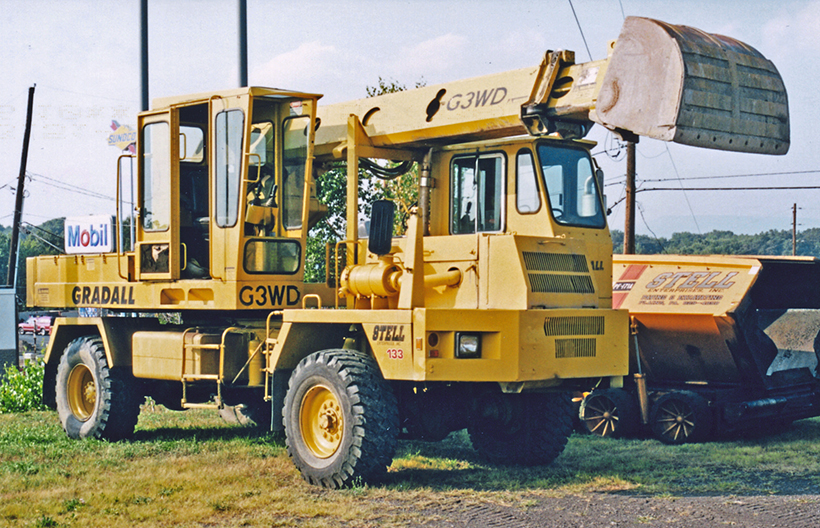
The model G-3WD is one of the smaller machines in the Gradall line. It uses a single engine in the carrier to power the excavator as well.
After receiving patents for their invention in 1944, Ray and Koop Ferwerda began to look for a manufacturer to buy their invention. Warner & Swasey Company (W&S) of Cleveland, Ohio, purchased the rights to its manufacture in 1945 and introduced the first Gradall, known as the model M-2400, the following year. It was mounted on an ex-Army surplus 6×6 truck. In 1950 W&S set up a separate division to manufacture Gradalls in a factory it had just purchased in New Philadelphia, Ohio. The model M-2460, with many improvements, soon followed.
Early hydraulic excavators
Since the first Gradall was built in 1941, the company has always claimed it produced the world’s first hydraulic excavator. This claim has not been disputed as a look-back in history puts it into perspective with other manufacturers.

The popular model G-660 had engines in the excavator as well as the truck carrier.
An early hydraulic excavator in the United States was the Hydrocrane, unveiled by the Milwaukee Hydraulics Corporation in 1946. Two years later, this company was purchased by Bucyrus-Erie Company which launched the model H-2 in 1948. This was the forerunner of Bucyrus-Erie’s long line of hydraulic excavators and cranes.
Turning to Europe, the Bruneri brothers in Italy produced a prototype test excavator in 1947, and followed it with various other prototypes, along with patents received in 1953 and 1955. The name Yumbo was adopted for these machines and design patents were eventually granted to SICAM in France, International Harvester in America and other companies in Germany and Japan.

Many Gradalls were supplied to the US military; this one is mounted on a tank.
In the 1950s and early 1960s, much research and development of hydraulic excavators took place in Europe. Well-established cable excavator manufacturers introduced hydraulic machines, while other companies produced hydraulic machines from their beginning. Notable makers with their first hydraulic machines include Poclain (1951), Atlas and Demag (1954), Liebherr (1955), Broyt (1956), Sennebogen & O&K (1961) and Hitachi in Japan (1965). As noted, these successful hydraulic manufacturers came to the market after Gradall was established, supporting the claim that the Gradall was the first.
Gradall moves ahead
In 1955, Warner & Swasey purchased the Duplex Truck Company of Lansing, Michigan, a builder of special vehicles and carriers. Then it became possible for W&S to supply carriers built ‘in-house’ for its Gradall excavators. These special carriers enhanced Gradall’s advantages even further, as now the machine could be legally driven at a reasonable speed over long stretches of public highways for a day’s job, then return in the evening with no need for a low-loader.
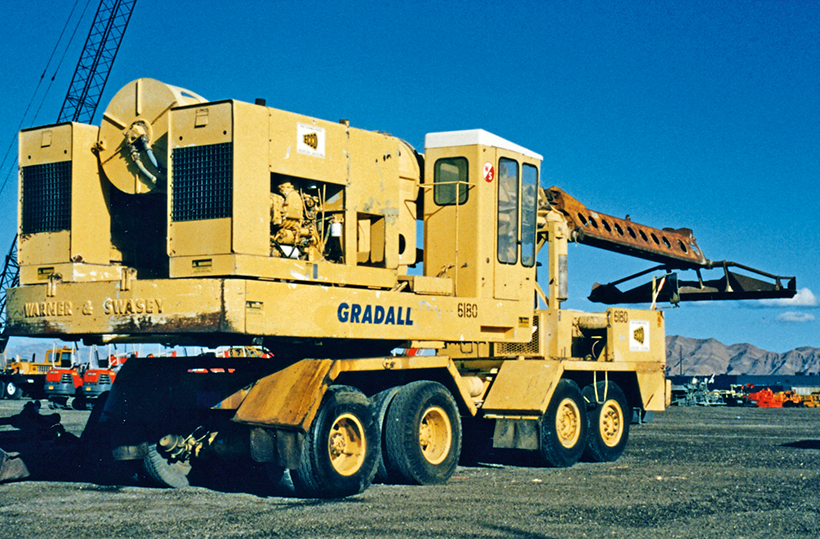
The biggest Gradall was the G-1000, shown here mounted on an 8×4 carrier with a 256hp diesel engine. The excavator was powered by another two diesels, each of 108hp.
W&S then began to set up dealerships throughout the world including Blackwood Hodge, for many years Gradall dealers in the United Kingdom. Old timers will remember that company’s famous advertising slogan, ‘Subsidiary Companies, Branches, Works and Agencies throughout the World.’
Over the years, Gradall introduced new or updated models which contributed to the machine’s continuing popularity. Machines on mobile (wagon) carriers with a single engine to power upper and lower assemblies were introduced, and crawler-mounted machines further expanded the machine’s capabilities. The big G-1000 of 1965 brought greater power and, with a boom extension capability of 15 feet, it could reach out 35 feet or dig a trench 18 feet deep. It carried two GM diesel engines in the upper structure, each of 108 horsepower. The G-1000 was available as a crawler machine or mounted on an 8×4 carrier designed and built by Warner & Swasey. The carrier’s engine was a 256hp International diesel.

The Gradall XL series utilises high-pressure piston pumps and advanced load-sensing hydraulics.
In 1992, Gradall launched a new line of excavators; the XL-series featuring load-sensing high-pressure hydraulics and piston pumps replacing the low-pressure gear pumps of former machines. The first machines were the crawler-mounted XL5200, and truck-mounted XL5100. These excavators were powered by a Cummins 162-flywheel horsepower engine, and a Cummins 225-flywheel horsepower engine powered the XL5100 carrier. Gradall added more XL models; the XL4200 and XL4100 crawler and truck models in 1993, and the small XL2200 crawler, and XL2300 wheeled excavators in 1998. The XL2200 weighed 26,600 pounds and carried a Cummins 80hp engine.
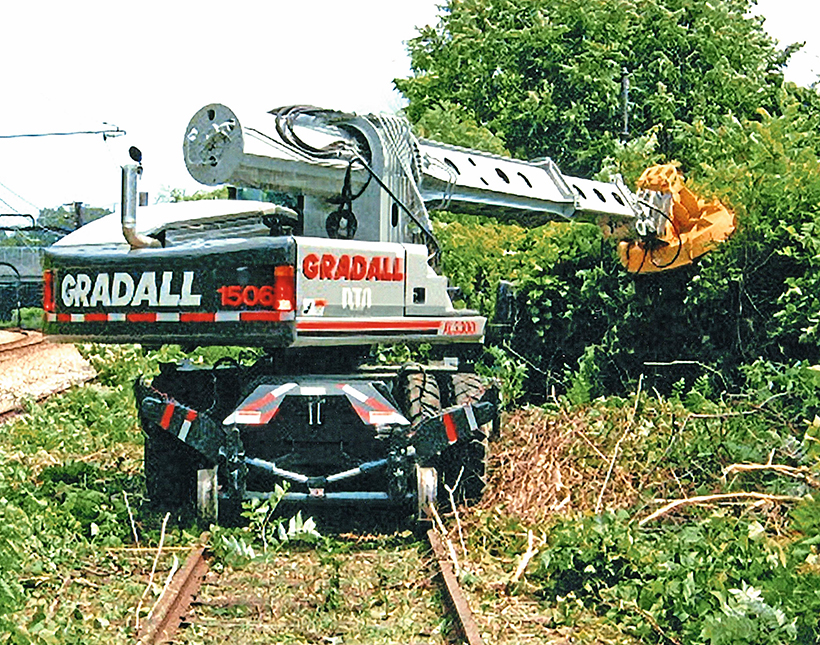
The model XL3300 ‘Track Star’ excavator has the capability to operate on regular tyres or on railway tracks.
In 1999, Gradall announced its 3100XL-series available on crawlers, wheels, or truck mount. These models rounded out its modern excavator line, and supplanted the last of its former G-series machines. At the 2005 Conexpo, Gradall introduced the new model XL3300 ‘Track Star’ excavator with capability to operate on regular tyres or on railway tracks. This was the latest in a long line of Gradall machines catering to railway companies who needed a versatile, self-propelled machine able to operate far from public road access.
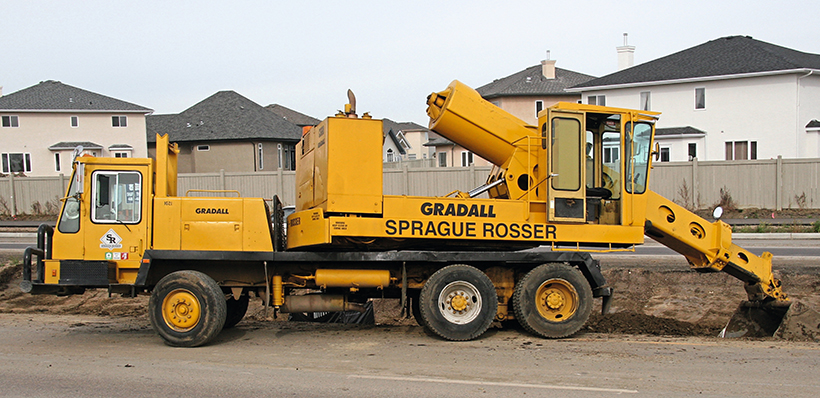
Here a truck-mounted G660 is seen working on a city road job.
Today Gradall remains a separate entity, but has experienced several different owners over its long history. In 1980 Bendix Corporation took over W&S but, at that time, Gradall was little affected. However, in 1983, Bendix itself was taken over by Allied Corporation which soon sold the Gradall Division to a group of Gradall executives who formed a company called Gradall Company LBO. In 1985, Gradall was acquired by ICM Industries, a Chicago-based consulting group. Then, in 1995, after three successive years of record revenues and profits, the New York investment group of Morgan, Lewis, Githens and Ahn took control of the company and directed its first public offering of stock. In 1999 JLG Industries, a world leader in aerial work platforms and telehandlers, acquired Gradall.
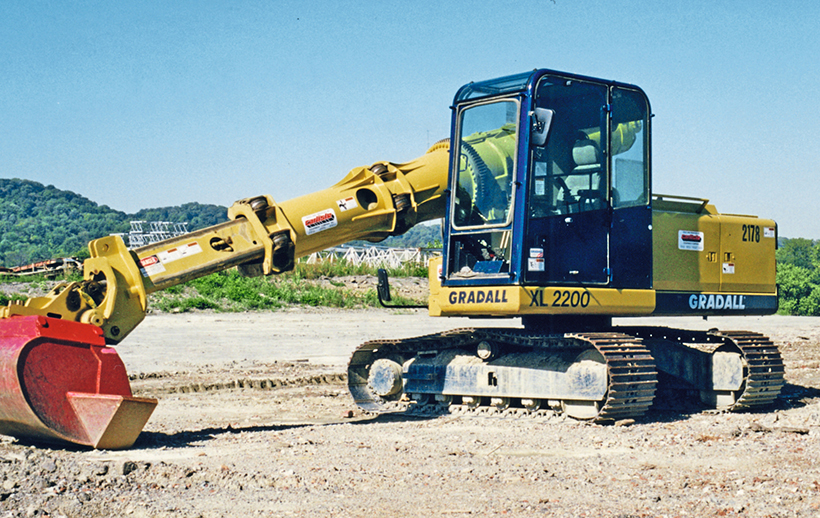
A crawler-mounted Gradall XL2200.
In 2006, Gradall was sold yet again, this time to the Alamo Group, headquartered in Seguin, Texas. This group operates some 14 factories in North America and Europe and manufactures a variety of forestry, road maintenance and agricultural equipment including mowers, sweepers and vacuum trucks.
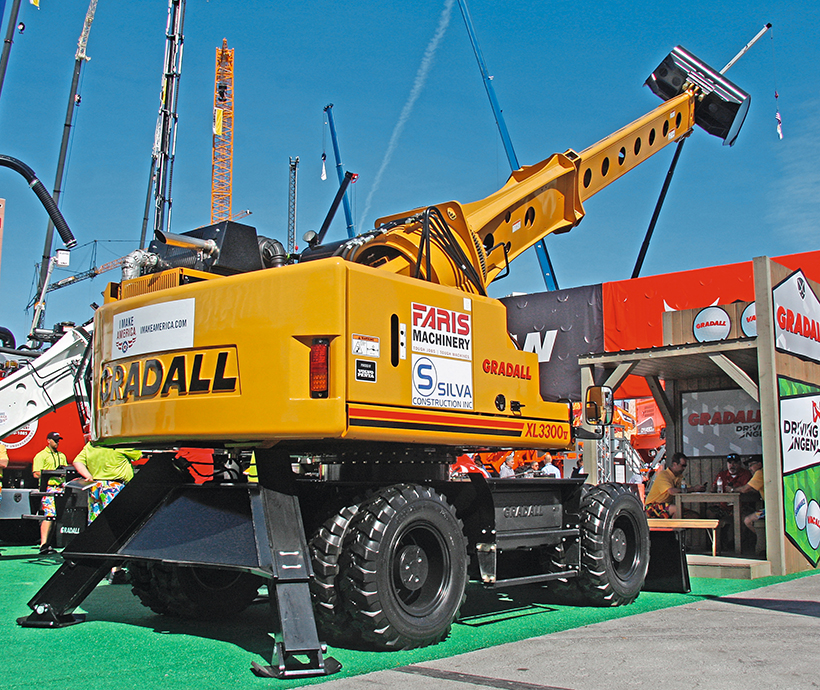
Conexpo 2017 saw the XL-3300 on display, one of the first Series V Gradalls. It is powered by a Volvo TAD571 engine developing 152hp net.
High-Tech Gradall
As the oldest and one of the very few remaining all-American-designed hydraulic excavator manufacturers, Gradall remains at the ‘cutting edge’ of technology. Although being produced at the same factory since 1950, modernisation of machine and manufacturing facilities have been key factors in its survival.
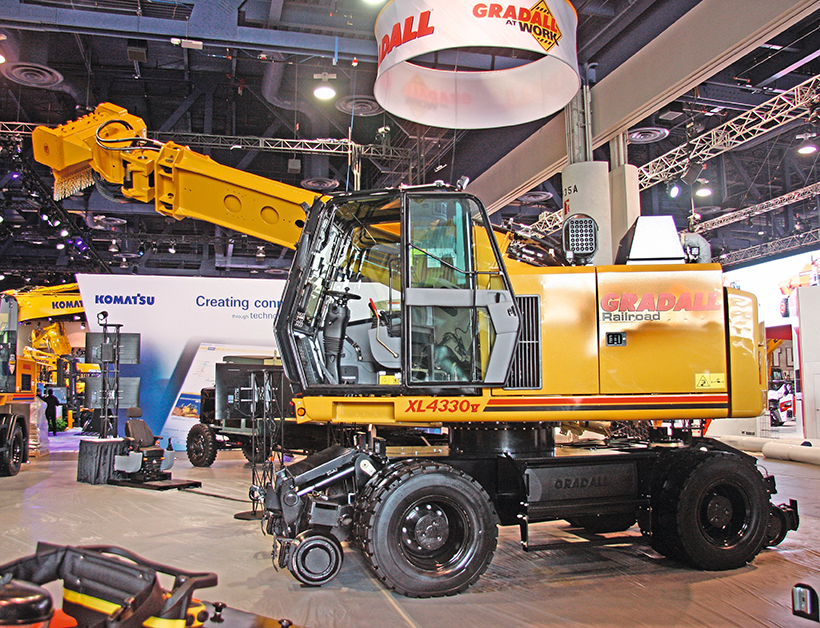
The model XL-4330A Series V. Another ‘Railroad’ Gradall able to travel on road or rail tracks.
In 2003, Gradall introduced its XL Series II excavators available with the usual crawler, wheeled or truck-mounted versions. The latter, in a first for Gradall, featured the excavator powered by the single engine mounted in the carrier. Doing away with the second engine resulted in reduced machine weight accompanied by less maintenance and parts requirement. Series III machines – the first appearing in 2006 – featured updated electronic joystick control as well as other electronic features to aid the operator.
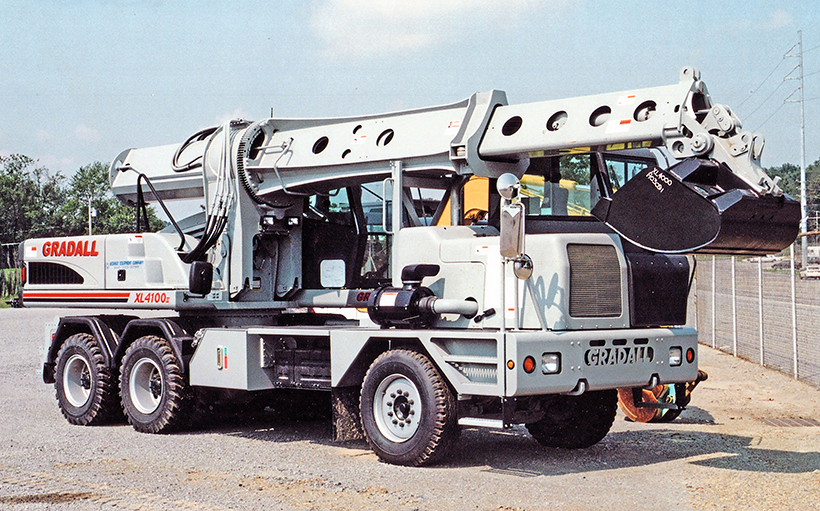
Launched in 2003, Gradall series II machines featured a single engine in the truck to also power the excavator.
On 24th June, 2016, Gradall rolled out its 20,000th excavator in a celebration at its New Philadelphia headquarters that included employees, retirees, community leaders and a variety of local, state and federal government officials. Still owned by Alamo today, Gradall Industries, Inc. operates as a separate division and remains at its New Philadelphia, Ohio, headquarters and factory.
This feature comes from a recent issue of Old Glory, and you can take advantage with a money-saving subscription to this magazine simply by clicking HERE
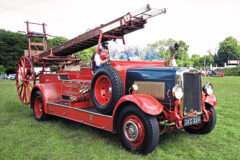
Previous Post
Glorious 1939 Leyland Pump Escape fire engine
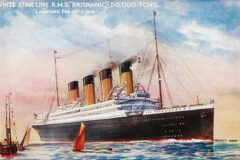
Next Post
White Star Line’s Olympic, Titanic and Britannic liners investigated



